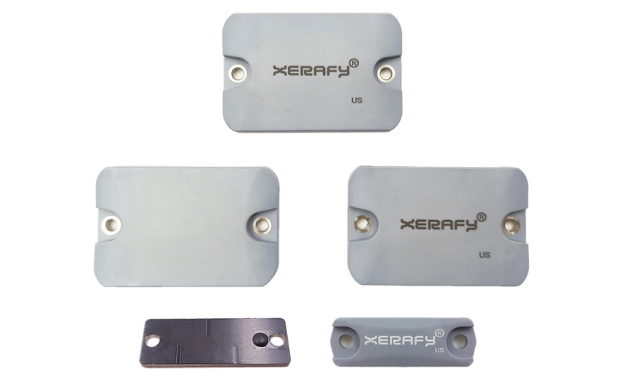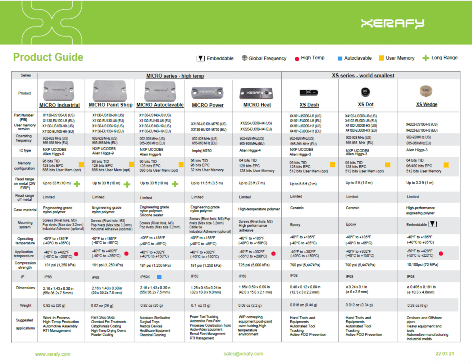Custom RFID Tags
Custom RFID Tags Are Printed and Encoded to Exact Specifications For The Tracking Of Critical Assets And Equipment

What Are Custom RFID Tags?
Custom RFID tags are standard tagging solutions that are fully personalized for RFID systems, to the exact specifications of the critical assets and equipment they are tracking.
Service Bureau customization options are available to mark and program RFID tags. On the other hand, RFID labels printing can be done in the field or taken care of by the Service Bureau.
And for unique requirements and features, it is also possible to custom build a tagging solution.
How To Print RFID Tags?
Hard tags are customized using physical markings to feature an asset identification number, a barcode, or a logo for instance.
Readable
Readable identifications, such as asset numbers, SKU, serial number, text, logo...
Optical
Optical barcode identifications, for instance: 1D Code 39 Regular, 1D Code 128, 2D QR, 2D Data Matrix...
The choice of a marking method will depend on the level of durability required, as well as on the material used for the tag’s case, to suit every use case.
printing
Branding or barcode: Thermal-printing, screen printing
Laser Etching
Directly on the case, for optimal durability in harsh environments
Custom RFID asset tags can be custom marked in the field, or be taken care of by the Service Bureau of the manufacturer or distributor.
How to Encode RFID Tags?
Programmable tags use RFID chips that are specifically designed with memory that can be written.
Password
Control access to the EPC writing feature
EPC ranges
Create unique identification numbers
This allows for the tags to be encoded with custom EPC ranges for unique identification, serialized or unserialized. The quantity of information that can be encoded will depend on the specifications of the chip being used.
Can You Custom Build an RFID Tag?
RFID tags can be designed specifically for a tracking system’s application and deployment requirements. They are then engineered and manufactured through a multi-step process.
This gives complete control over every aspect and requirement of the RFID tagging solution, including form factor, packaging durability, mounting system, user memory, range with RFID readers, accuracy printing, encoding, IOT features, software configuration, as well as budget.
Connected assets offer examples of such RFID tagging solutions that have been engineered for equipment that OEMs have designed with RFID and IOT features built-in.
Custom RFID Tag: Selecting the right chip and antenna
The RFID chip, also known as an integrated circuit (IC), is the brain of the RFID tag. It is produced by semiconductor manufacturers who design and manufacture the ICs.
RFID Chips
RFID chips available from reputable vendors: Impinj, NXP, Asygn, Alien, Fujitsu...
IOT features
Encoding, programming, sensing, monitoring features
The IC is responsible for making decisions, storing data, implementing communication protocols, and encoding/decoding digital signals during communication between the tag and the interrogator.
It can also store important information like the tag ID, object identifier, password, and error detection codes. ICs are created on a large semiconductor wafer, individually tested, and then attached to the RFID tag’s antenna.
The antenna is another vital component of an RFID tag. Its primary function is to receive signals from the interrogator and either transmit or reflect the received signal back, depending on the type of tag.
For passive tags, the antenna also collects power from the radio waves and supplies it to the IC. The design and geometry of the antenna are determined by the tag’s operating frequency, allowing for variations in behavior and properties. Typically, antennas are made of thin metal strips that are deposited on a substrate using methods such as copper etching, foil stamping, or screen-printing.
Custom RFID Tag: What material to use to make the tag substrate?
The materials used to make the tag substrate need to possess the ability to withstand a wide range of environmental conditions throughout the life cycle of the tag.
Commonly used substrate materials include:
- RFID labels: Polymers, PVC, Polyethylenetherephtalate (PET), phenolics, polyesters, styrene, paper, etc.
- Durable RFID tags: Ceramic, various qualities of PCB, etc.
Metal
Performance on-metal or multi-surface for versatility
RFID Frequencies
RF frequency ranges tailored to work with regional or global RAIN RFID frequencies
The choice of substrate material is crucial as it serves several important functions:
- Dissipate any static buildup that may occur: This helps to prevent any damage to the tag and its components.
- Smooth printing surface, which is necessary for laying out the RFID antenna design effectively.
- Durability and stability under various operating conditions, to withstand factors such as heat, moisture, vibration, chemicals, sunlight, abrasion, impact, and corrosion. The substrate material plays a vital role in offering mechanical protection to the antenna, chip, and their interconnections.
- Effect on design frequency of the antenna: Impact of the substrate material during the proper tuning of the antenna, as it can directly influence its performance.
Custom RFID Tag: How is the tag going to be packaged?
Tag packaging is the process of embedding RFID chips into tags by the manufacturer or the converter.
The choice of a form factor, such as a flexible label or a hard encapsulation, is process-specific and will be based on application requirements.
Form factor
Hard tags, flexible, labels, inlays, sensors
Size
Striking the right balance between size, profile, and RF performance
In the initial stage, a tag is created as an inlay or insert. An inlay is a complete RFID tag consisting of an integrated circuit (IC) and an antenna, both of which are affixed to a substrate. The substrate, typically lacking adhesive properties, acts as a carrier for the IC and antenna.
During production, the inlays are supplied on a reel of continuous web, making it easier for label makers to assemble labels using high-speed equipment. The continuous form of inlays facilitates the efficient integration of RFID functionality into a large number of labels.
Custom RFID Tag: How is the tag attached to the asset?
A tag is typically attached to an object by coating one side of the substrate with an adhesive material. This adhesive material is carefully selected to ensure it can withstand the relevant environmental conditions.
Additionally, to offer extra protection against environmental effects, a protective overlay consisting of materials such as PVC lamination, epoxy resin, or adhesive paper may be applied to cover the tag.
Mounting
Hard tags: Rivets, screws, adhesive, welding, zip ties.
Labels: Adhesive options suited to the nature of the asset surface and the application environment.
Durability
Heavy-duty tags, reusable tags, laminated labels, disposable inlays, protective carriers.
